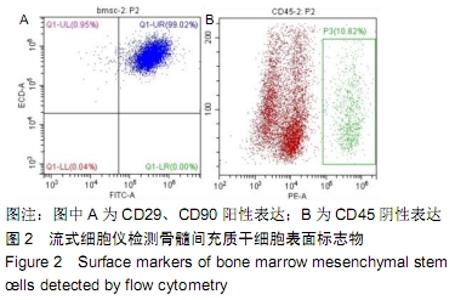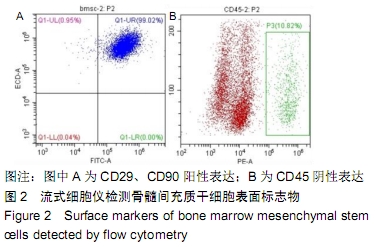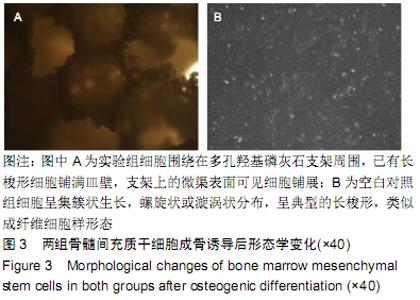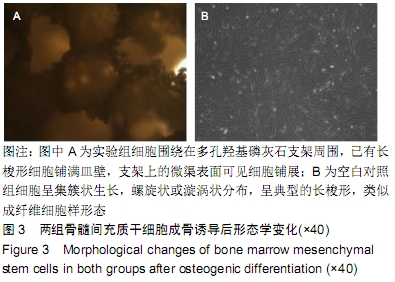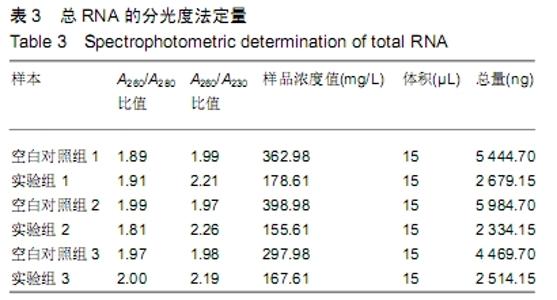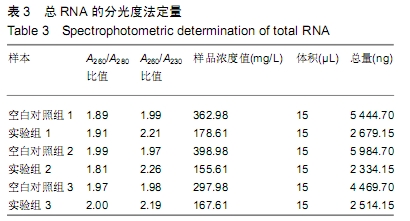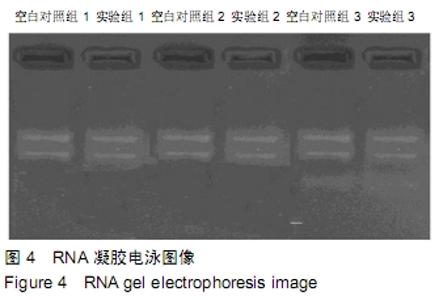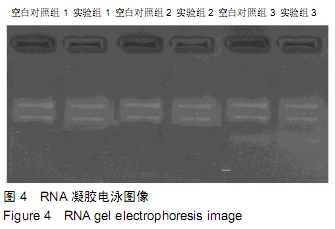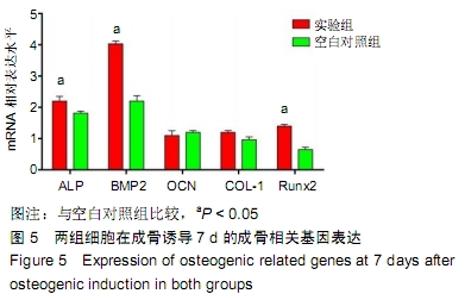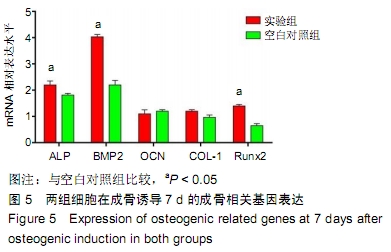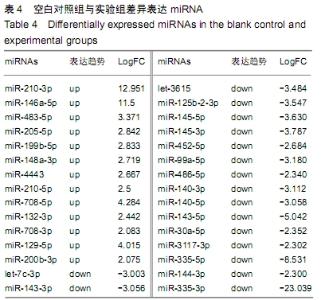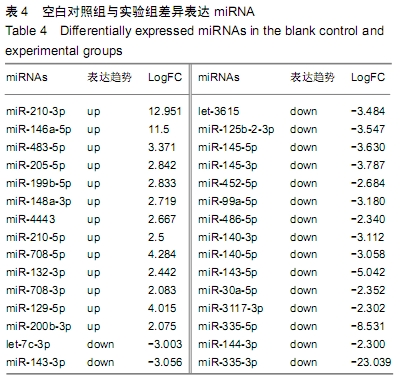Chinese Journal of Tissue Engineering Research ›› 2020, Vol. 24 ›› Issue (13): 1989-1995.doi: 10.3969/j.issn.2095-4344.2053
Previous Articles Next Articles
miRNA expression profiling of osteogenic differentiation of bone marrow mesenchymal stem cells induced by microchannel porous hydroxyapatite scaffold
Zheng Jiajun1, Qing Wei1, Huang Lijuan1, Ren Jing1, Liu Chunhui2, Peng Pairan1, Huang Jie1, Mu Yandong1, 2
- 1School of Stomatology, Southwest Medical University, Luzhou 646000, Sichuan Province, China; 2School of Medicine, University of Electronic Science and Technology, Chengdu 610000, Sichuan Province, China
-
Received:2019-09-16Revised:2019-09-18Accepted:2019-10-31Online:2020-05-08Published:2020-03-07 -
Contact:Mu Yandong, MD, Chief physician, School of Stomatology, Southwest Medical University, Luzhou 646000, Sichuan Province, China; School of Medicine, University of Electronic Science and Technology, Chengdu 610000, Sichuan Province, China -
About author:Zheng Jiajun, Master candidate, Physician, School of Stomatology, Southwest Medical University, Luzhou 646000, Sichuan Province, China -
Supported by:the Project of Science & Technology Department of Sichuan Province, No. 2016TD0008
CLC Number:
Cite this article
Zheng Jiajun, Qing Wei, Huang Lijuan, Ren Jing, Liu Chunhui, Peng Pairan, Huang Jie, Mu Yandong . miRNA expression profiling of osteogenic differentiation of bone marrow mesenchymal stem cells induced by microchannel porous hydroxyapatite scaffold[J]. Chinese Journal of Tissue Engineering Research, 2020, 24(13): 1989-1995.
share this article

对31个差异表达的miRNA的目标基因行GO分析得到623条Go terms,其中包括了387个生物学过程,上调的14个miRNA靶基因主要参与的生物学过程有生物学调节、细胞基因表达、基因表达调节等,主要包括NF-κB、Toll样受体9、细胞间黏附、白细胞介素1调节、血管生成、Hippo等信号通路。 2.8 qRT-PCR验证测序结果 为了进一步验证测序结果的真实精确,在实验组最终分析数据中选取miRNA上调最明显的2个miRNA分子进行实时荧光定量qPCR,纳入实验的是miR-210-3p、miR-146a-5p。空白对照组和实验组培养7 d的总RNA样本,重复测量3次,利用qRT-PCR检测miR-210-3p、miR-146a-5p的相对表达量,结果显示miRNA-210-3p在实验组上调15倍,miR-146a-5p在实验组上调10倍,且差异有显著性意义(P < 0.05),见图8。由此可见qRT-PCR与miRNA测序结果一致,表明上述高通量测序的结果是可信的。 "

| [1] ELANGO J, ZHANG J, BAO B, et al. Rheological, biocompatibility and osteogenesis assessment of fish collagen scaffold for bone tissue engineering. Int J Biol Macromol. 2016;91:51-59. [2] SABURI E, ISLAMI M, HOSSEINZADEH S, et al. In vitro osteogenic differentiation potential of the human induced pluripotent stem cells augments when grown on Graphene oxide-modified nanofibers. Gene. 2019;696:72-79. [3] ABAZARI MF, SOLEIMANIFAR F, ENDERAMI SE, et al. Incorporated-bFGF polycaprolactone/polyvinylidene fluoride nanocomposite scaffold promotes human induced pluripotent stem cells osteogenic differentiation. J Cell Biochem. 2019;120(10): 16750-16759. [4] MONTECINO M, STEIN G, STEIN J, et al. Multiple levels of epigenetic control for bone biology and pathology. Bone. 2015;81:733-738. [5] OTHMAN Z, FERNANDES H, GROOT AJ, et al. The role of ENPP1/PC-1 in osteoinduction by calcium phosphate ceramics. Biomaterials. 2019;210:12-24. [6] LI X, GUO L, LIU Y, et al. MicroRNA-21 promotes osteogenesis of bone marrow mesenchymal stem cells via the Smad7-Smad1/5/8-Runx2 pathway. Biochem Biophys Res Commun. 2017;493(2):928-933. [7] BAGLÌO SR, DEVESCOVI V, GRANCHI D, et al. MicroRNA expression profiling of human bone marrow mesenchymal stem cells during osteogenic differentiation reveals Osterix regulation by miR-31. Gene. 2013;527(1):321-331. [8] ZHOU Z, LU Y, WANG Y, et al. Let-7c regulates proliferation and osteo-differentiation of human adipose-derived mesenchymal stem cells under oxidative stress by targeting SCD-1. American Journal of Physiology-Cell Physiology. 2018; 316(1):57-69. [9] JIN T, LU Y, HE QX, et al. The Role of MicroRNA, miR-24, and Its Target CHI3L1 in Osteomyelitis Caused by Staphylococcus aureus. J Cell Biochem. 2015;116(12):2804-2813. [10] LIAN JB, STEIN GS, VAN WIJNEN AJ, et al. MicroRNA control of bone formation and homeostasis. Nat Rev Endocrinol.2012;8(4):212-227. [11] VOLINIA S, CROCE CM. Prognostic microRNA/mRNA signature from the integrated analysis of patients with invasive breast cancer. Proc Natl Acad Sci U S A. 2013;110(18):7413-7417. [12] BARTEL DP. MicroRNAs: genomics, biogenesis, mechanism, and function. Cell. 2004;116(2):281-297. [13] REN X, TUO Q, TIAN K, et al. Enhancement of osteogenesis using a novel porous hydroxyapatite scaffold in vivo and vitro. Ceramics International. 2018;44(17):21656-21665. [14] LI J, ZHI W, XU T, et al. Ectopic osteogenesis and angiogenesis regulated by porous architecture of hydroxyapatite scaffolds with similar interconnecting structure in vivo. Regen Biomater. 2016;3(5): 285-297. [15] 温永梅,牟雁东,伍佳,等.新型多孔羟基磷灰石陶瓷支架在骨内成骨的初步评价[J].中国口腔种植学杂志,2017,22(1):9-12,28. [16] CHEN J, ULERICH JP, ABELEV E, et al. An investigation of the initial attachment and orientation of osteoblast-like cells on laser grooved Ti-6Al-4V surfaces. Materials Science and Engineering: C. 2009; 29(4):1442-1452. [17] ENGELMAYR GC JR, PAPWORTH GD, WATKINS SC, et al. Guidance of engineered tissue collagen orientation by large-scale scaffold microstructures. J Biomech. 2006;39(10):1819-1831. [18] HATA A, KANG H. Functions of the bone morphogenetic protein signaling pathway through microRNAs (review). Int J Mol Med. 2015; 35(3):563-568. [19] KANG H, HATA A. The role of microRNAs in cell fate determination of mesenchymal stem cells: balancing adipogenesis and osteogenesis. BMB Rep. 2015;48(6):319-323. [20] ARFAT Y, XIAO WZ, AHMAD M, et al. Role of microRNAs in osteoblasts differentiation and bone disorders. Curr Med Chem. 2015;22(6):748-758. [21] KOMORI T. Roles of Runx2 in Skeletal Development. Adv Exp Med Biol. 2017;962:83-93. [22] ULUDAG H, GAO T, PORTER TJ, et al. Delivery systems for BMPs: factors contributing to protein retention at an application site. J Bone Joint Surg Am. 2001;83-A Suppl 1(Pt 2):S128-135. [23] ZHAO YP, TIAN QY, FRENKEL S, et al. The promotion of bone healing by progranulin, a downstream molecule of BMP-2, through interacting with TNF/TNFR signaling. Biomaterials. 2013;34(27):6412-6421. [24] CHANG N, GE J, XIU L, et al. HuR mediates motility of human bone marrow-derived mesenchymal stem cells triggered by sphingosine 1-phosphate in liver fibrosis. J Mol Med (Berl). 2017;95(1):69-82. [25] ESKILDSEN T, TAIPALEENMÄKI H, STENVANG J, et al. MicroRNA-138 regulates osteogenic differentiation of human stromal (mesenchymal) stem cells in vivo. Proc Natl Acad Sci U S A. 2011; 108(15):6139-6144. [26] SUGATANI T, HRUSKA KA. MicroRNA-223 is a key factor in osteoclast differentiation. J Cell Biochem. 2007;101(4):996-999. [27] HU B, LI Y, WANG M, et al. Functional reconstruction of critical-sized load-bearing bone defects using a Sclerostin-targeting miR-210-3p-based construct to enhance osteogenic activity. Acta Biomater. 2018;76:275-282. [28] MIZUNO Y, TOKUZAWA Y, NINOMIYA Y, et al. miR-210 promotes osteoblastic differentiation through inhibition of AcvR1b. FEBS Lett. 2009;583(13):2263-2268. [29] GIANNAKAKIS A, SANDALTZOPOULOS R, GRESHOCK J, et al. miR-210 links hypoxia with cell cycle regulation and is deleted in human epithelial ovarian cancer. Cancer Biol Ther. 2008;7(2):255-264. [30] KONG Y, CHEN ZT. MiR-146a regulates osteogenic differentiation and proliferation of bone marrow stromal cells in traumatic femoral head necrosis. Eur Rev Med Pharmacol Sci. 2019;23(2):441-448. [31] WU H, FAN H, SHOU Z, et al. Extracellular vesicles containing miR-146a attenuate experimental colitis by targeting TRAF6 and IRAK1. Int Immunopharmacol. 2019;68:204-212. [32] MATYSIAK M, FORTAK-MICHALSKA M, SZYMANSKA B, et al. MicroRNA-146a negatively regulates the immunoregulatory activity of bone marrow stem cells by targeting prostaglandin E2 synthase-2. J Immunol. 2013;190(10):5102-5109. [33] LI C, YANG L, REN X, et al. Groove structure of porous hydroxyapatite scaffolds (HAS) modulates immune environment via regulating macrophages and subsequently enhances osteogenesis.J Biol Inorg Chem. 2019;24(5):733-745. |
| [1] | Geng Yao, Yin Zhiliang, Li Xingping, Xiao Dongqin, Hou Weiguang. Role of hsa-miRNA-223-3p in regulating osteogenic differentiation of human bone marrow mesenchymal stem cells [J]. Chinese Journal of Tissue Engineering Research, 2021, 25(7): 1008-1013. |
| [2] | Liu Cong, Liu Su. Molecular mechanism of miR-17-5p regulation of hypoxia inducible factor-1α mediated adipocyte differentiation and angiogenesis [J]. Chinese Journal of Tissue Engineering Research, 2021, 25(7): 1069-1074. |
| [3] | Liu Bo, Chen Xianghe, Yang Kang, Yu Huilin, Lu Pengcheng. Mechanism of DNA methylation in exercise intervention for osteoporosis [J]. Chinese Journal of Tissue Engineering Research, 2021, 25(5): 791-797. |
| [4] | Liu Jiangfeng. Nano-hydroxyapatite/polyamide 66 composite filling combined with locking plate in the treatment of fibrous dysplasia of femoral bone [J]. Chinese Journal of Tissue Engineering Research, 2021, 25(4): 542-547. |
| [5] | Ye Haimin, Ding Linghua, Kong Weihao, Huang Zutai, Xiong Long. Role and mechanism of hierarchical microchanneled bone scaffolds in promoting osteogenesis and angiogenesis [J]. Chinese Journal of Tissue Engineering Research, 2021, 25(4): 621-625. |
| [6] | Chen Ziyang, Pu Rui, Deng Shuang, Yuan Lingyan. Regulatory effect of exosomes on exercise-mediated insulin resistance diseases [J]. Chinese Journal of Tissue Engineering Research, 2021, 25(25): 4089-4094. |
| [7] | He Lin, Wu Xi, He Song, Yang Sen. Hydrophilicity and cell adhesion of hydroxyapatite bioceramics after the coating of polydopamine [J]. Chinese Journal of Tissue Engineering Research, 2021, 25(22): 3540-3544. |
| [8] | Li Zhen, Huang Yonghui, Sun Jifu, Sun Haitao. Role and mechanism of focal adhesion kinase in inducing osteogenic differentiation of mouse embryonic fibroblasts cells [J]. Chinese Journal of Tissue Engineering Research, 2021, 25(2): 165-171. |
| [9] | Guo Zhibin, Wu Chunfang, Liu Zihong, Zhang Yuying, Chi Bojing, Wang Bao, Ma Chao, Zhang Guobin, Tian Faming. Simvastatin stimulates osteogenic differentiation of bone marrow mesenchymal stem cells [J]. Chinese Journal of Tissue Engineering Research, 2021, 25(19): 2963-2968. |
| [10] | Wang Liu, Song Dongzhe, Huang Dingming. Bone morphogenetic protein 9 regulates stem cell differentiation and bone regeneration [J]. Chinese Journal of Tissue Engineering Research, 2021, 25(19): 3064-3070. |
| [11] | Yuan Changshen, Rong Weiming, Lu Zhixian, Duan Kan, Guo Jinrong, Mei Qijie. Construction of osteosarcoma miRNA-mRNA regulatory network based on bioinformatics [J]. Chinese Journal of Tissue Engineering Research, 2021, 25(17): 2740-2746. |
| [12] | Chen Liang, Meng Shu, Cheng Guoping, Ding Yi . Effects of fish scale collagen membrane on adhesion, proliferation and osteogenic differentiation of rat bone marrow mesenchymal stem cells [J]. Chinese Journal of Tissue Engineering Research, 2021, 25(16): 2494-2499. |
| [13] | Wang Renxian, Cao Jingjing, Wang Honggang, Wan Ben, Liu Weifeng. Effects of dispersants on aggregation, intracellular distribution and cell proliferation of nano-hydroxyapatite [J]. Chinese Journal of Tissue Engineering Research, 2021, 25(16): 2500-2505. |
| [14] | Wang Hongyuan, Wang Wei, Yang Shuqing, Dou Lixin, Liu Lijun. Preparation and properties of porous nitrogen oxygen bioglass scaffold for bone repair [J]. Chinese Journal of Tissue Engineering Research, 2021, 25(16): 2521-2527. |
| [15] | Meng Maohua, Li Ying, Chen Xin, Cheng Lu, Dong Qiang. Effects and mechanisms of enamel matrix derivatives on osteogenic differentiation of bone marrow mesenchymal stem cells [J]. Chinese Journal of Tissue Engineering Research, 2021, 25(13): 2108-2113. |
| Viewed | ||||||
|
Full text |
|
|||||
|
Abstract |
|
|||||


